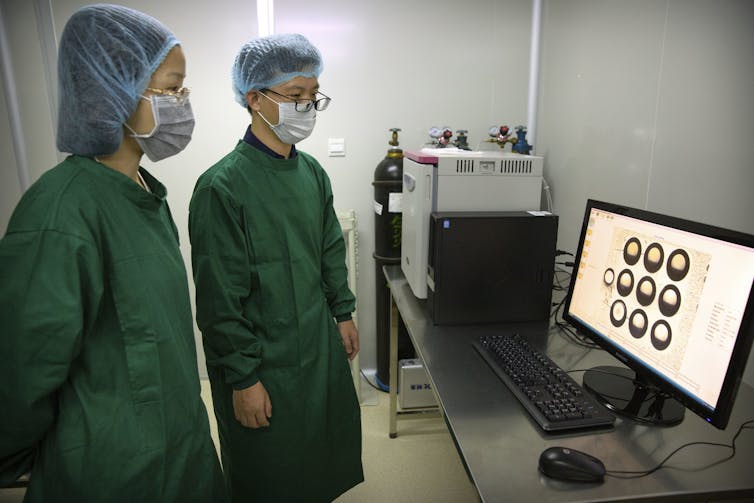Screening the human future: YouTube, persuasion and genetically engineered children
- Written by George Estreich, Instructor, Oregon State University, Oregon State University
On Sunday, Nov. 25, the scientist He Jiankui claimed the birth of the world’s first genetically engineered children: twins, created by IVF, their DNA altered at fertilization. Changes like these, because they’re inheritable – “editing the germline” – are widely prohibited by law and avoided by scientific consensus. If He really did this, it’s a very big step across a very bright line.
Also, He announced the feat in a YouTube video.
The strangeness of this choice cannot be overstated. Groundbreaking achievements normally appear in prestigious journals, with extensive data, after rigorous peer review. Announcing the accomplishment on YouTube is the social media equivalent of walking out the front door and yelling, “Guess what, everybody? I’m the first to engineer a human being! And the kids are already here – they’re twins!” The timing of the video’s release – on the eve of a major international conference on genome editing, where He was scheduled to speak[1] – clearly had more to do with publicity than science.
Others have written on the science[2] and ethics[3] involved. I’m a writer, so what interests me is persuasion: the way literary tools, like story and metaphor, help pave the way for cutting-edge biotechnology. Researching a forthcoming book[4] on this topic, I came to see that human-focused biotech and persuasion form a single system: for the biotech to be adopted, the public has to accept it first. He’s video is a textbook bid for acceptance, an argument for germline editing aimed at the general public.
But the video is a low-rent production. It’s just He, standing in a lab, talking to the camera in English (it’s subtitled). As such, the video doesn’t hold a candle to the polished emanations of established research institutes or multimillion dollar corporations. The writing isn’t great either. Effective persuasion guides us lightly from one place to another: the lightest touch on your shoulder, redirecting your path. Listening to He is more like being yanked down a slippery slope.
And yet for precisely that reason, the video[5] deserves a closer look: Seeing the pitch in its most obvious form, we can learn to recognize the patterns.
The family success story
The video begins with He beaming at the camera, describing “two beautiful little Chinese girls named Lulu and Nana,” a few weeks old, “as healthy as any other babies.” According to He, their parents, Mark and Grace, had always wanted to have a family. But Mark is HIV-positive, and stigma had deterred them. Now, because of He’s experiment – which was intended to make the twins permanently immune to HIV infection – a happy family exists. “The babies are home now with their mom Grace and their dad Mark,” He says.
“Mark” and “Grace,” their real names changed for privacy, may be real. Rhetorically, though, their function is to humanize a new technology. Ironically, that technology is changing what it means to be human in the first place.
Portrait of a scientist
Persuasion means crafting a persona, and He is clearly going for approachable scientist and family man. Identifying himself as “a father of two girls,” He also suggests his own humility, by saying, “Mark’s words taught me something I didn’t fully appreciate.” That lesson? “Gene surgery” helps more than a child: “We heal a whole family.”
That feigned humility doesn’t square with what He actually did: rushing to be first across the germline, thereby putting his experimental human subjects, and any of their descendants, at risk. Given all this, He’s assertion that he’s willing to brave controversy on behalf of the parents – “I’m willing to take the criticism for them” – rings just a tad hollow.
 Zhou Xiaoqin, left, and Qin Jinzhou, embryologists working with He Jiankui, view a time lapse image of embryos on a computer screen.
AP Photo/Mark Schiefelbein[6]
Zhou Xiaoqin, left, and Qin Jinzhou, embryologists working with He Jiankui, view a time lapse image of embryos on a computer screen.
AP Photo/Mark Schiefelbein[6]
Metaphors, omissions and weasel words
Obviously, selling a new technology means putting it in the best possible light. Trying to do this, He makes an odd choice. Instead of “CRISPR-Cas9,” the common name, he insists on the phrase “gene surgery.” It’s a naked attempt to make CRISPR sound precise, like a molecular scalpel. That metaphor is misleading. CRISPR is improving in accuracy, but as geneticist Eric Topol wrote in The New York Times[7], unintended edits still occur – “We don’t have the assurance yet that Crispr provides laserlike precision in editing” – and we might not always detect them. “Our ability to discern these changes is still rudimentary, and it is entirely likely that we will miss something,” Topol added.
But the surgery metaphor has another function: It likens the radically new to the comfortably familiar. He continues this theme with a second (mixed) metaphor: “The surgery removed the doorway through which HIV enters to infect people.”
A doorway is easy to imagine – and who could oppose slamming the door on AIDS? And yet the metaphor glosses over the complications of actual biology. It is true that people with a variation in the CCR5 gene have natural resistance to HIV. But other strains can infect the body via a different protein[8], which He left untouched. There is, in other words, more than one doorway. Complicating things further, having a variant CCR5 gene may protect you from HIV, but it also makes you more vulnerable to dying from West Nile virus[9] or the flu[10].
Also omitted from He’s video: the number of failed attempts required to get one successfully engineered baby. He’s team began with 22 embryos, but in the end only one pregnancy succeeded. Of the implanted twins, one, at best, is protected against HIV. (Our genes come in pairs; in one twin, only one gene was modified, not both.)
So when He asserts that “the surgery worked safely, as intended,” you have to remember that “safe,” like “health” and “choice,” is a useful weasel word: positive but vague, its meaning dependent on context. “Safe” could simply mean that the babies were born and appear to be okay. It does not mean they will be free from unanticipated effects, or protected from HIV.
Reason, emotion and the dismissal of critics
In arguments for new biotechnologies, it’s common to deride critics as fearful or irrational. He’s video is no exception. In it, he asserts that “the media hyped panic about Louise Brown’s birth as the first IVF baby.” Building on this theme in a second video (there are five in all[11]), He inveighs against the phrase “designer baby[12],” contrasting “vocal critics” with silently suffering families. By implication, you’re either pro-technology or pro-suffering. That’s a false binary, of course: Untested treatments can lead to suffering.
But He’s pitch also illuminates a common problem. In arguments like these, the categories of reason and emotion are invoked in contradictory ways. If people disagree with you, they’re dismissed as panicky and irrational. If they’re sympathetic parents who bolster your case, though, then their emotions are authoritative. In the second video, He contrasts parents and an unnamed naysayer: “[The parents] may not be the director of an ethics center quoted by the New York Times, but they are no less authorities on what’s right and wrong, because it’s their lives on the line.”
Actually, it’s their children’s lives on the line. Also, invoking sympathetic parents is itself an emotional appeal.
Nana, Lulu: You’ve got mail
 Lulu and Nana have their own email address.
Lightspring/Shutterstock.com[13]
Lulu and Nana have their own email address.
Lightspring/Shutterstock.com[13]
Because independent verification is still lacking, reports about Lulu and Nana tend to use the phrase “if true.” It’s appropriate, somehow, that the possibility of human germline enhancement – insistently discussed and envisioned, from bioethics conferences to movies with genetically upgraded superheroes – still seems half-imaginary, a projection, an event with deep roots in the digital and shallow roots in the real.
At the end of the video, He invites you to email his lab and share your thoughts. But weirdly – and, by the end of the video, the bar for weird is very high — you can email Lulu and Nana themselves at DearLuluandNana@gmail.com. Perhaps they’ll have Twitter and Instagram accounts soon? Perhaps, one day, there’ll be a LuluAndNana.com, with an online fan club and emailed testimonials? In the meantime, the twins, engineered or not, expand into the world of information, where persuasion tries to reproduce itself. To go, in our biology-based metaphor, viral.
The twins’ email address is, of course, a PR gimmick. Emailing two Chinese infants (and why don’t they have their own addresses? They’re two people, after all) is about as meaningful as texting in a vote for this year’s “American Idol.” But we can learn something from the ploy: that inheritable human modification is too serious a matter for fake participation, and that a more substantive engagement is called for. If our species is to be engineered, then we all ought to have a say.
References
- ^ where He was scheduled to speak (theconversation.com)
- ^ science (www.theatlantic.com)
- ^ ethics (www.theguardian.com)
- ^ a forthcoming book (mitpress.mit.edu)
- ^ the video (www.youtube.com)
- ^ AP Photo/Mark Schiefelbein (www.apimages.com)
- ^ The New York Times (www.nytimes.com)
- ^ via a different protein (doi.org)
- ^ West Nile virus (doi.org)
- ^ the flu (doi.org)
- ^ five in all (www.youtube.com)
- ^ inveighs against the phrase “designer baby (www.youtube.com)
- ^ Lightspring/Shutterstock.com (www.shutterstock.com)
Authors: George Estreich, Instructor, Oregon State University, Oregon State University


